Selling to businesses can be far more complicated than selling to consumers. With business-to-consumer (B2C) sales, businesses need only convince one person to purchase their services or products. With business-to-business (B2B) sales, multiple decision-makers are involved, each with different emotional drivers and pain points.
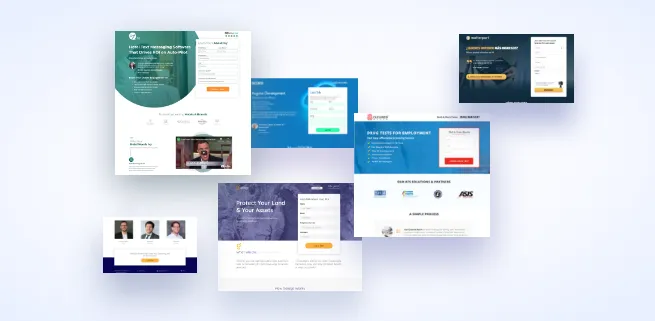
This can cause complications in the sales process, which means it’s important to optimise B2B landing pages for the best results.
This difference in the complexity of B2B and B2C sales leads obviously means that the landing pages for each will differ dramatically and, what works for selling to a consumer, may not work when selling to a business.
Before we get into optimisation tips, there are a few basics to cover. Landing pages, often referred to as ‘lead capture pages’ are designed to do just that - capture leads. They exist solely to capture the contact information of visitors, through the use of a form. In exchange for this information, the prospect obtains whatever you are offering.
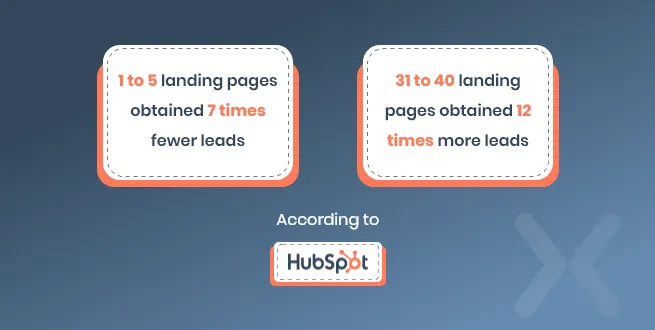
According to HubSpot, businesses with only 1 to 5 landing pages obtained 7 times fewer leads than those with 31 to 40 landing pages. Businesses with 40 or more landing pages generated up to 12 times more leads.
Even if you’ve never utilised a landing page before, creating them can be painless if you follow some basic principles. Any landing page should contain the following key elements:
A catchy and effective headline and sub-headline which correspond to your CTA
A brief description of your offer, which accurately and clearly describes its benefits
Relevant supporting images and logos
A well-optimised form to capture your visitor’s contact information Other supporting elements are optional, such as security badges or testimonials
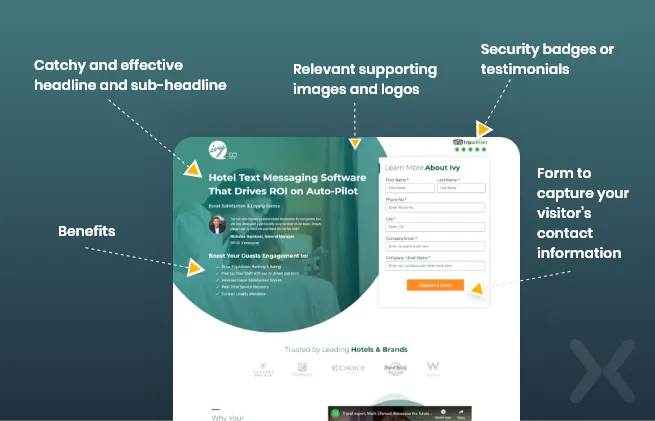
Once you have a grasp on the basic anatomy of a landing page, we can get into the process of how to optimise B2B landing pages for new leads.
Optimisation should begin at creation, and you should start following optimisation best practices when first creating your landing page. Understand B2B landing page strategy and look for other B2B landing page examples to make sure your landing page works from the start.
To create great B2B landing pages that convert, keep the following steps in mind:
Before you begin creating landing page designs, you first need to have a goal in mind. This goal will influence everything that appears on your page - from the design to the messaging and the CTA.
Your landing page should only have one single purpose - for instance, getting visitors to sign up for a free trial. Attempting to achieve multiple goals with one landing page could confuse users, and cause the page to underperform.
To create great B2B landing pages that convert, you want the goal or purpose of the page to be so obvious that there is no room for misinterpretation. Make sure that there is only one path for users to follow.
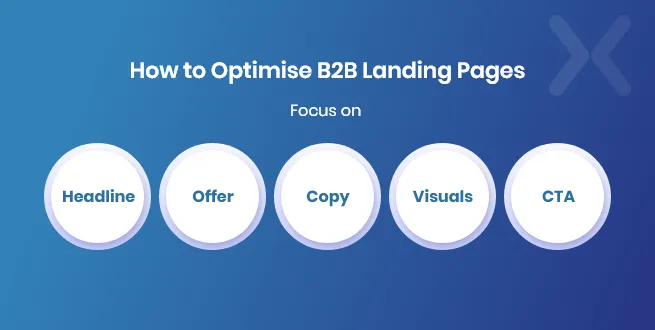
Focus on Messaging and Content: When you optimise B2B landing pages, messaging and content are the first things to focus on, as they are what convince visitors to take the desired action.
Headline: Your headline should be prominent, as well as clear and concise. It needs to persuade visitors to take action. Things like bold colours, big letters, and centre placement tend to work well for headlines. A good way to see how effective your headline is, is the “2-second test.” Can a first-time reader understand your headline within 2 seconds?
Offer: The offer is the incentive you give visitors to part with their contact information. This can be a white paper, a free consultation, a trial period, or anything in between. Especially in the B2B market, users can be hesitant to part with their contact information, so your offer should be valuable enough to entice them.
Copy: Your landing page copy should accurately reflect your audience’s intent and understanding. For example, visitors with only surface knowledge of your niche would require different copy than experts. For this reason, a good B2B landing page strategy is to have multiple landing pages for different types of users, or users in different stages of the funnel.
To keep your visitors engaged, your landing page copy should make use of short, prominent, and compelling bullet points. Longer, in-depth copy can be used below the fold.
Visuals: While images can be effective, if you’re looking to create a high-converting B2B landing page, videos are better. Videos tend to be more engaging, increasing time spent on your page and improving conversion rates.
Calls-to-Action: To optimise B2B landing pages, make sure your calls-to-action are short and direct. Leave no room for misinterpretation.
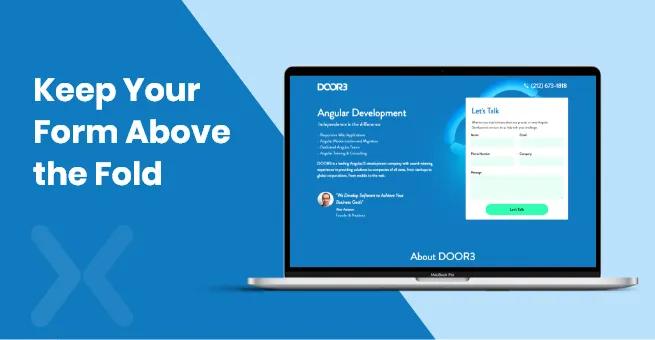
Users can be lazy. Most people don’t like to scroll down your page to find what they’re looking for, and putting your form at the bottom of the page can lower your conversion rate. To encourage users to fill in the form, it should be one of the first things a visitor sees when they arrive on your page.
Another important thing to remember is that your page should be clear and to the point. Clutter can lead to distraction, which lowers conversion rates.
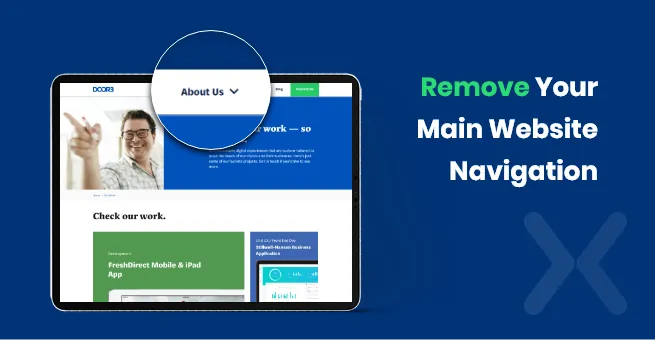
Once a visitor lands on your page, you need to keep them there and give them as few options as possible. Remember, your landing page should have a single goal - getting them to fill in a form. While it can be tempting to build your landing page around the normal infrastructure of your site, that will ultimately prove a distraction.
Good B2B landing page strategy is to remove all navigation links from your page, and avoid including any other links that could take the user away from the page.
Though it may seem counterintuitive, and you may worry about ‘losing’ visitors who don’t want to fill in a form straight away, including links and other navigation can decrease your conversion rate.
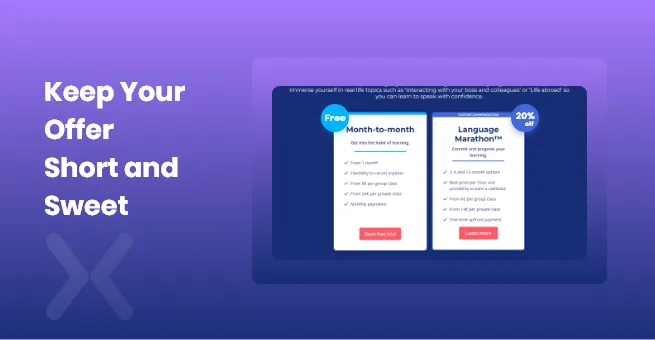
Similar to the above point, avoid confusing, distracting, or overwhelming your visitors with reams and reams of copy. Keep your descriptive text and your offer short and to-the-point. Be clear about your offer and the benefits, as well as what you’re asking for in return. Remember, the more a visitor has to read, the less likely they will be to take action.
Keep your copy straightforward and simple. While it’s important to be brief, you don’t need to be boring. Use bullet points to emphasise the benefits of your offer, and keep your copy easy-to-read and concise.
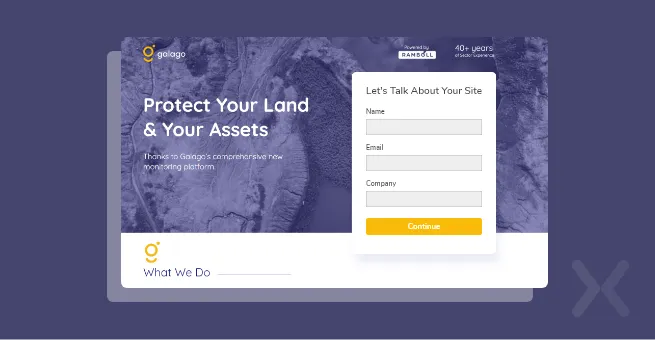
One of the most important steps when looking to optimise B2B landing pages is to optimise your forms. Consider the length of the form and which questions are strictly necessary.
Though there is no universal answer for exactly how many fields your form should contain, the rule of thumb is to only ask for the information you really need. You can also make your form look shorter by reducing the amount of spacing between the fields.
Your ‘submit’ button is the next thing to optimise. It should reflect the benefit that a visitor will receive when submitting their information. Focus on what they will get, rather than what they’re handing over.
Lastly, try to add a privacy message to your form, indicating to visitors that their information will not be shared or sold. Most people are often reluctant to share their information, especially in a B2B scenario, and this message can be helpful. Customer testimonials, certifications, and safety badges can also go a long way in letting visitors know that their information is secure.
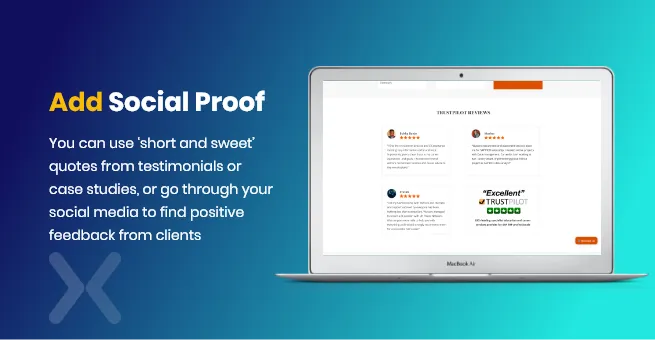
Adding social proof can greatly improve your conversion rates. You can use ‘short and sweet’ quotes from testimonials or case studies, or go through your social media to find positive feedback from clients.
You can embed these tweets or Facebook comments on your landing page, as plain copy won’t add the same kind of credibility. Another type of social proof that can be effective is statistics about how many people currently use your product or service.
To create landing pages that convert, you need to optimise consistently.
There are certain practical metrics that will inform your optimisation, and when you optimise B2B landing pages, these are the metrics that you should focus on.
Users: How many people are visiting your landing page?
Traffic source/medium: Which source and channel generated most of your traffic e.g., “Google/CPC” or “website.com/referral.”
Abandonment rate: How many visitors started filling out your form but did not complete it? This metric can indicate problems with your form, such as ease of use, length, and the types of questions you’re asking.
Conversion rate: The percentage of visitors who complete the desired action, such as completing the form.
Cost per conversion: A self-explanatory metric. How much does each conversion cost? This allows you to compare traffic sources in terms of cost per conversion and see which traffic source brings the most cost-effective leads.
Lead-to-customer rate: How many leads become customers? Leads are not worth much if they do not eventually become customers.
Cost per customer: Based on your cost per conversion lead-to-customer rate, how much does it cost to generate a customer? You can use this metric to calculate how much to pay for web traffic.
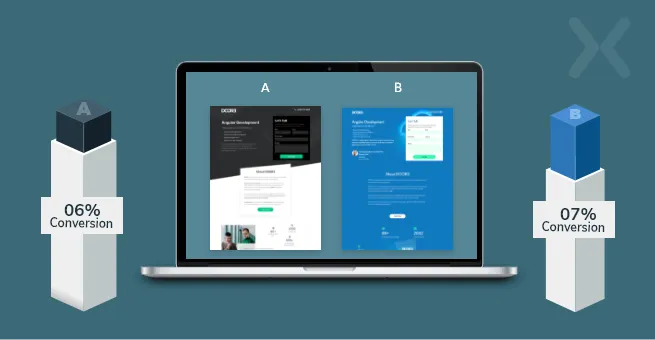
The most important step: use A/B testing to constantly improve the performance of your landing pages. When A/B testing, it’s important to make only one small change at a time. If you make multiple changes simultaneously, it will be almost impossible to tell which one actually made the difference.
Some key elements to consider changing during your A/B tests include; your headline, visuals, CTA, copy, and your form - both length and questions.
Sell the need, not the product: While your product or service is doubtlessly important, without the need for it, it wouldn’t exist. When creating copy for your B2B landing page, you should focus on providing for the needs of your prospects - answering their questions or solving their problems. To do this, you need to know exactly who your market is. Once you understand your market, it will become easier to offer the right content to convince them to use your product or service.
Forget the window dressing: Occasionally, looking good is all you need to do. Unfortunately, when you optimise B2B landing pages, just looking good isn’t going to cut it. Your landing page design needs to be functional, rather than aesthetically pleasing. Avoid designs that will hinder your prospects from completing your desired goal, or leave them feeling confused or distracted. A clean and concise landing page design will do more for your conversion rate than a cutting-edge design or over-the-top images.
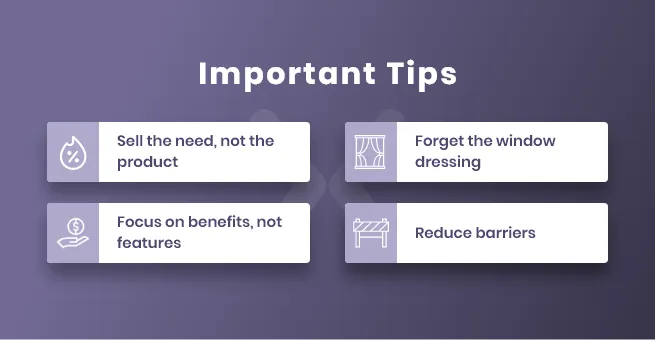
Focus on benefits, not features: It’s important to remember that your prospects have needs they are trying to fulfil. While the features of your product or service may be amazing, what’s important to your visitors is how it will improve their life or business. Use bullet points and clear copy to highlight the benefits they will receive from using your product or service, and only use jargon when strictly necessary.
Reduce barriers: As mentioned many times, you should keep your landing page, be it for any industry SaaS, finance, insurance, etc., as simple as possible to give prospects no excuses to not take action. Remove all hindrances. Keep your forms short, only ask for necessary information, and make sure the path to goal-completion is clear. For many B2B, their forms are a way of getting information from a prospect. However, many prospects can be scared away by having to share too much information too soon.
To optimise B2B landing pages, make sure you reduce the effort and commitment required for visitors to complete your form. Leave the information gathering for the lead-nurturing phase.
Following this “how to” guide should help you to improve lead generation and capturing. However, if you still don’t know what to do, Apexure can provide the extra boost you need.
Apexure’s B2B lead generation landing pages can help you on your way to capturing new leads. We understand the inner workings of customer conversion and how to use all options available to help build your brand and grow your business. Contact us for all of your B2B landing page needs.
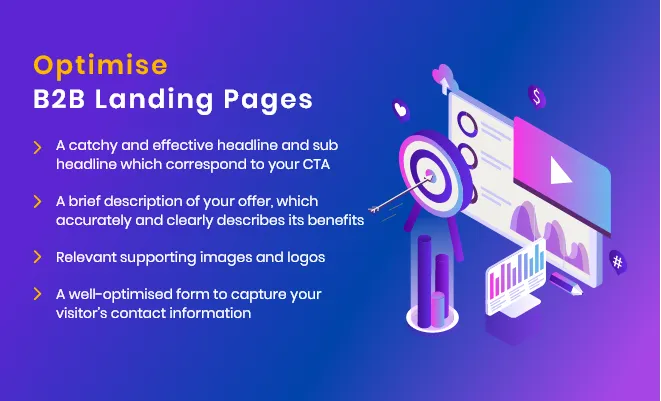
Related Articles:
Drive More Sales or Leads With Conversion Focused Websites and Landing Pages
Get Started.webp)
In today’s fast-paced digital world, having a responsive website is no longer just a nice-to-have, it’s essential. Whether...
As artificial intelligence continues to evolve, businesses are finding innovative ways to enhance their marketing efforts. One of...
Get quality posts covering insights into Conversion Rate Optimisation, Landing Pages and great design